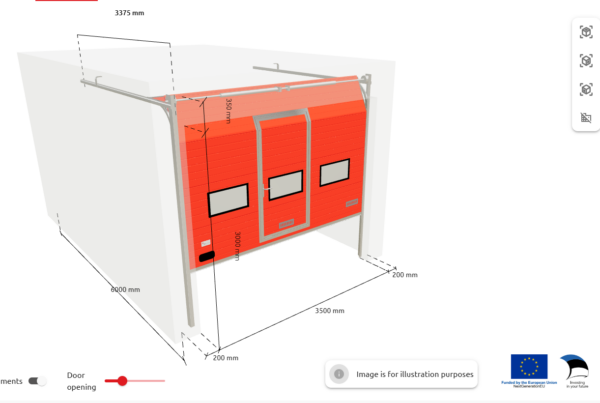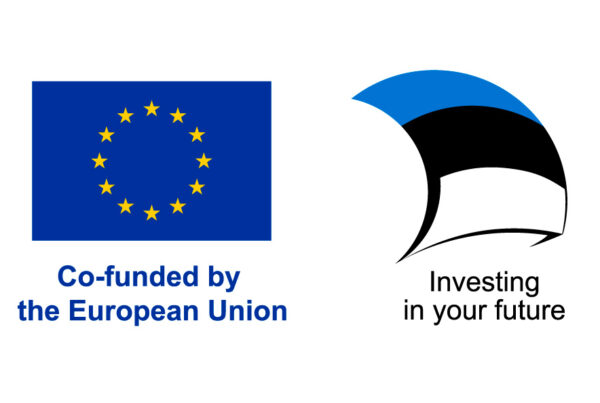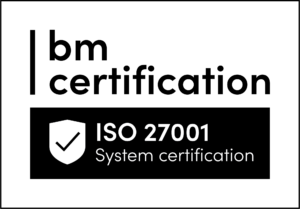Tormis Lilleväli, the project manager for Wenture software development, introduces the solar panel configurator created for Solarstone and its innovative features.
Buying solar panels might feel like a bit of a headache. When do they become cost-effective? How many should I purchase? What kind of roof is suitable for the panels?
Customers shouldn’t have to handle these analyses and calculations on their own. A product configurator can handle these technical questions on behalf of the customer.
Tormis, you and your team have developed a product configurator to assist Solarstone in selling solar panels. What specific business challenges was the configurator designed to address?
Absolutely, we’re thrilled with the outcome of our extensive work on this powerful tool. Our main objective for this project was to enhance the efficiency of the sales team.
Solarstone approached us with a concern about the sluggish pace of their sales process. Their salesmen dedicated a considerable amount of work time to gathering precise measurements from clients. Moreover, customers often lacked the expertise to provide detailed information, which made it challenging to create accurate inquiries.
However, we knew that the essential information already existed in different databases – customer data in national databases and Solarstone’s product data in their internal system. This realization meant that all calculations could be automated.
Our task was to devise a solution that would seamlessly integrate this data, streamlining the sales process. And thus, the solar panel configurator was born.
Introduce this configurator in more detail. Based on what data is the inquiry and quotation created?
Certainly, let’s delve into the details of this configurator.
To initiate a query, the user goes through a couple of straightforward steps: entering the building address and positioning the panels on the roof. Let’s break down these stages.
Firstly, the user visits the Solarstone configurator page and inputs their building address. Then they get an aerial view of their house and the dimensions of the roof. Since the portal is connected to different databases, information exchange happens automatically.
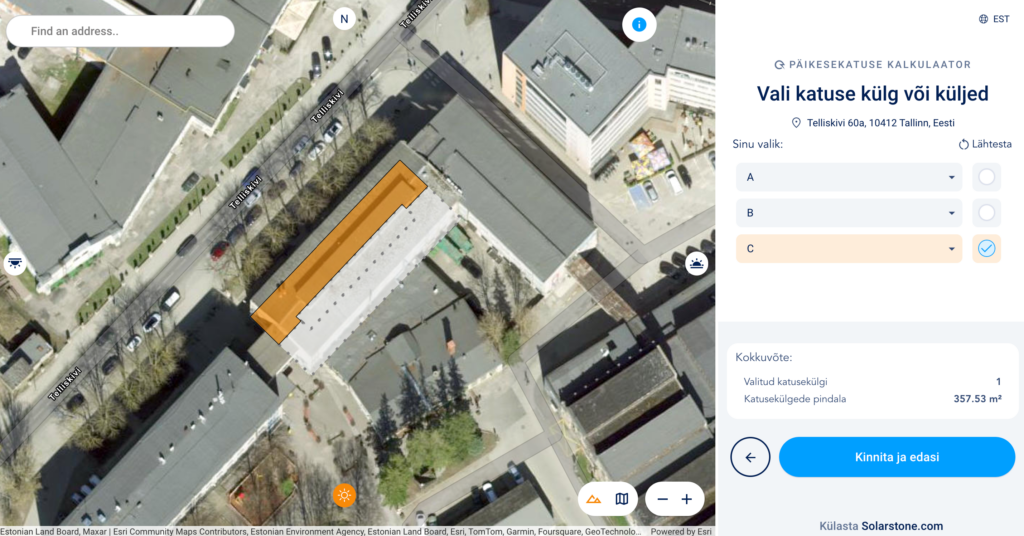
solar panel configurator
For instance, using lidar data, the configurator obtains details about the roof size, orientation, slope, and its alignment with the sun. The Maa-amet geoportal helps display a visual representation of the roof on the screen. Additionally, to calculate the price and roof productivity, the specifications of Solarstone’s panels are utilized. These are the kinds of data that a customer would typically struggle to gather on their own.
The user can also specify which sides of the roof they want the panels on. Depending on the type of roof, the configurator suggests suitable solar panels. For this, the configurator first generates digital roof sides, onto which it places the panels. The customer can then rearrange these panels according to their preferences.
 Additionally, the customer can visually see the result on the screen. Based on various studies, we know that when a customer sees the product they are considering, their confidence in making the purchase increases, expectations become more realistic, and ultimately, satisfaction with the outcome is higher.
Additionally, the customer can visually see the result on the screen. Based on various studies, we know that when a customer sees the product they are considering, their confidence in making the purchase increases, expectations become more realistic, and ultimately, satisfaction with the outcome is higher.
Thanks to data from the European Union, we also have information on the intensity of sunlight in a given location. The customer can calculate the power and quantity of their solar panels, determining the productivity of the panels each month.

Once the number of solar panels and materials have been calculated, the customer can send an inquiry to Solarstone. It’s crucial that, while playing with the calculator, the customer gains an understanding of the profitability of their investment and how it changes in different situations. It’s noteworthy that the price calculation for panel placement is updated in real-time, meaning the user constantly sees the current indicative price.
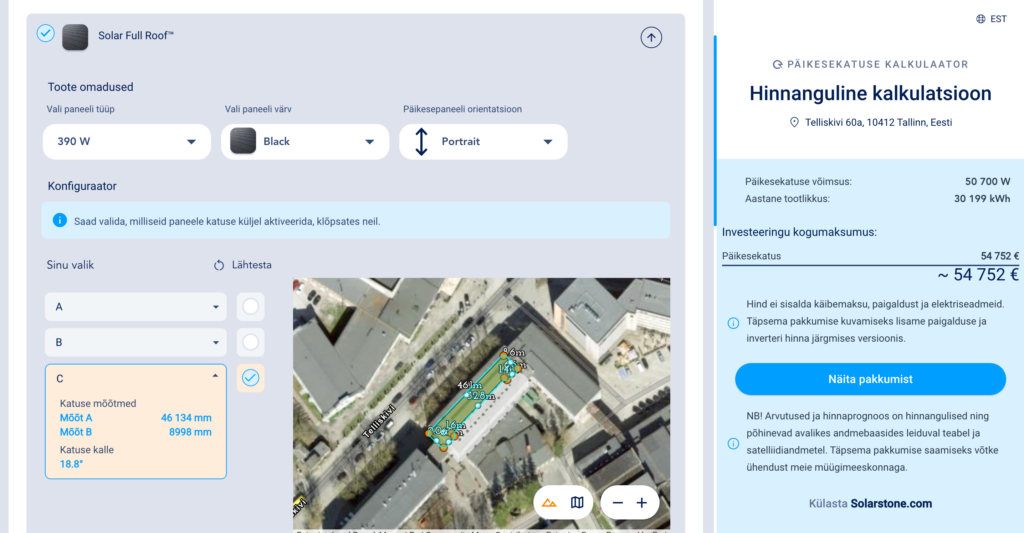
Finally, a properly formatted inquiry reaches the sales department of Solarstone. Now, a Solarstone salesperson only needs to review the data briefly and provide clarifications to the customer if necessary.
Which do you consider the configurator’s greatest advantages?
Certainly, there are numerous advantages to the configurator. I’ll mention a few where the difference compared to manual inquiries is particularly noticeable.
Firstly, we see a reduction in errors, incorrectly ordered products, and returns. This is because the configurator minimizes misunderstandings between the customer and the sales department. The customer doesn’t need to search for their data; it is automatically retrieved from the databases.
Secondly, the customer journey from the initial idea to the inquiry is significantly shorter. If previously customers spent a lot of time on Google searching, comparing, and calculating, we now facilitate their decision-making by simplifying and clarifying the calculation process. The customer gains a comprehensive overview of the product’s price, profitability, and appearance incredibly quickly – what used to take months now happens in just a few minutes.
Thirdly, as the customer gets a very precise visualization, sales volume increases. The customer simply feels more secure when the process has been transparent and visualized for them, allowing them to independently see how different choices affect the product’s appearance and functionality.
What were the major challenges in the project?
Typically, we encounter a good idea that needs a bit of polishing – and this time was no different. In the case of Solarstone, it was a project that demanded a novel approach. However, research and development always consume a considerable amount of resources.
Our task is to work with the client to figure out the best way to solve the business problem. Collaborating with the client, we established the project requirements, but the core idea remained the same. Essentially, we provided a product owner service.
The project involved numerous stakeholders – our development and UI/UX team, Proekspert AS working on the same project, the client’s team with various ideas. Additionally, we had to communicate with different databases and establish effective communication bridges between all parties.
In such a large team and project, it’s easy to get bogged down in details, but when developing an application, we mustn’t forget the big picture and understand the user journey from start to finish. While every puzzle piece is crucial, the emphasis lies in how they come together to form a cohesive whole.
What’s your advice to companies who consider showcasing their products in a configurator?
I believe it’s only a matter of time before such products become the norm among construction supply sellers. Therefore, it makes sense to start sooner rather than later. In competitive conditions, customers typically choose a provider who is the simplest, clearest, and most transparent for them.
However, when ordering a project, it’s essential to consider that the clearer the goal, the better the end product. It’s worth establishing all business requirements upfront and being open to various scenarios for solving the project. Ultimately, our job is to find the most efficient output for a specific company.


